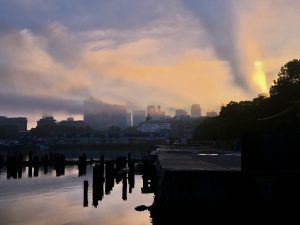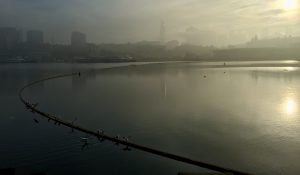Asa Wahlquist, Glebe Society Bulletin 4/2021 June 2021
The Community Consultative Committee for the current works on the new Sydney Fish Market has been expanded by one, to enable The Glebe Society to be a community representative.
Initially, the Society was overlooked and not appointed to the Committee. But after a letter to the Minister for Planning, Rob Stokes, pointing out the size of the Glebe Society, its history in leading the fight for the foreshore walk and its effective representation of its members, the minister’s office sent a letter stating the Department had endorsed Asa Wahlquist, from the Society, as a stakeholder representative.
The Committee meets monthly to discuss issues arising out of the current works on the new fish market site. It has stakeholder reps from Sydney Secondary College, which is adjacent to the site, Dragon Boats NSW and Glebe Rowing Club, which use the waters of Blackwattle Bay, the residents of 84 Wentworth Park Rd, which is opposite the main gate to the development, Pyrmont Action Group, Blackwattle Bay Residents Group and the Coalition of Glebe Groups.
There are also three individual community representatives, John Faulkner, who has a long association with the fish market and lives close by, Paul McGuirr, who has owned the Kauri Hotel for over 30 years, and Lindsay Charles, from Pyrmont. The representatives were appointed from a large number of applicants, some from far afield. The chair, David Johnson, said they wanted locals on the committee.
The first meeting was held on 12 March. It was well attended, with Deputy Lord Mayor of Sydney, Jess Scully, in attendance along with two representatives of Multiplex and two attendees from Infrastructure NSW.
Hansen Yuncken has completed the early stage. Most of the built infrastructure, including the wharves, has been removed, along with many of the piles which supported the wharves.

The main issues have been dust and noise complaints, although they did cease noisy work during exams at Sydney Secondary College at the request of the principal, Leiza Lewis. There has also been a problem with the silt boom, which is in place to catch pollutants disturbed by the removal of piles, which has been getting in the way of recreational boating.
David Maher from Multiplex said there is still work to be done removing piles and seawall revetment. Between 600 and 800 piles have been removed so far, with another 400 still to go.
The Glebe Society raised the question of pollution from heavy metal contaminants and other toxins in the mud, which will be disturbed by removing the piles. The Development Application for the Fishmarket reported:
Heavy metal, PAH (polycyclic aromatic hydrocarbons) and TRH (total petroleum hydrocarbon) contaminated sediments have been identified within the extent of the development site that were reported to exceed both low and high trigger value sediment quality guidelines protective of ecological communities. (E.I.S. 7.10.3 p. 156).
The heavy metals that exceed the high trigger values include Mercury, Lead, Zinc, Copper and Nickel, while Arsenic was also found (DA, Appendix 4, Figure 4B).
The Glebe Society fears that disturbing these pollutants could threaten the 26 fish species and over 50 other organisms, including oysters, shrimp, limpets, sponges and algae, that live in the Bay. The Glebe Society requested a briefing on how the silt boom will work and what water quality tests will be taken.
The remaining piles will be removed in May and June, after which new piles will be installed.
Mr Maher said Multiplex will be putting in some test piles, using ‘silent’ sheet piling technology from Japan.
Dredging is not permitted under the consent conditions of the DA, but ‘silt reprofiling’, i.e., removing silt from the site, is permitted.
The strata body of 84 Wentworth Park Rd has commissioned an independent noise impact assessment for their property, which is not yet available.
The Rowers, Dragon Boaters and Ms Lewis, whose students are active rowers, were all concerned about the number of barge and tug movements in and out of the Bay. Mr Maher said the conditions of consent limited barge movements to nominated hours, and they must operate within a Vessel Traffic Management Plan.

Jess Scully was particularly interested in how the works would affect Bridge Rd, and the impact on cyclists. (The Bridge Rd pop-up cycleway ends before the fish market site, so cyclists ride out on the roadway).
The works will clearly impact traffic, including cyclists and pedestrians, along Bridge Rd.
Despite the intention to bring a lot of the building materials in and out by barge, there will be many truck movements onto the site through the entrance at the end of Wentworth Park Rd. It is hard to see how they will manage to conduct all their works on the remaining narrow wharf, without spilling out onto Bridge Rd. The Glebe Society will be keeping a close eye on the impact of the works on Bridge Rd, on the effect of the noise and dust on local residents, and problems with workers parking in Glebe streets.
The hours of work are 7 am to 5.30 pm, Monday to Friday, and 7.30 am to 3.30 am on Saturday. There will be no work on Sundays or public holidays. The Fish Market is expected to be completed by 2024.
Complaints can be made to: blackwattle.bay@infrastructure.nsw.gov.au










There are no comments yet. Please leave yours.